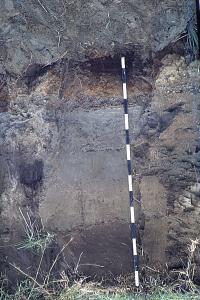Reference soil Kenya 04: Phaeozem
Phaeozems occur all over the world, but especially on the more moist side of the steppe regions, bordering Chernozems.
Characteristics
Soils having a mollic horizon (deep, brownish or blackish surface horizon with a significant accumulation of organic matter and high base saturation); a base saturation of 50 percent or more between 25 and 100 cm from the soil surface; a calcium carbonate-free soil matrix at least to a depth of 100 cm from the soil surface, or to a contrasting layer between 25 and 100 cm; no diagnostic horizons other than an albic, argic, cambic or vertic horizon, or a petrocalcic horizon in the substratum.
Reference soil KE004: Phaeozems
Location: grit numbers: 21.6.9 E, 98.86.7 S / Classification: Eutric Regosol? Typic Ustorthent? / Additional notes on profile description: Ah: the lowest 2-5 cm pumiceous gravel; somewhat stratified at places; roots especially in the upper 10 cm; C: very dark greyish brown (2.5Y 3/2) in upper part to very dark grey (2.5Y 3/0) in lower part (moist); the lowest 20 cm with small volcanic glass fragments; upper part stratified; roots concentrated in cracks and above the layer with glass; C2: gravel layer of pumice.
